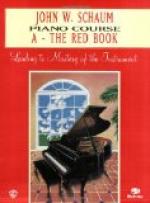As a pianist Mr. Burnham takes high rank. Technical difficulties do not exist for him. He has come to the last turning of the road; before him rise the heights of supreme spiritual mastery. A touch that is limpid, clear, and capable of many gradations of tints; splendid power in fortissimo; delicacy, velocity and variety are all his; together with all this he has a sympathetic insight into the mood and meaning of the composer. Of late he has been giving several recitals of a semi-private nature, at which he has brought out some of the larger works in his repertoire. These recitals have taken place in his charming studios, and it was my good fortune to be present when two concertos were played, the MacDowell in D minor, and the Grieg in A minor. Mr. Burnham is a warm admirer of the works of our great American composer, and has prepared an entire program of MacDowell’s music, which included the Tragica Sonata, Polonaise, and many of the shorter pieces.
In a conversation with Mr. Burnham in regard to methods of teaching, he gave many helpful points, explaining how he had reduced technical difficulties to a minimum through the exercise of a few simple principles.
PRINCIPLES OF TOUCH
“The position and condition of the hand varies according to the character of the music, and the tone you wish to produce. If you give out a melody, you want a full, luscious tone, the weight of arm on the key, everything relaxed, and a clinging, caressing pressure of finger. Here then, you have the ‘Melody Hand,’ with outstretched, flat fingers. If, on the contrary, you want rapid passage work, with clear, bright, articulate touch, the hand must stand up in well-arched, normal playing position, with fingers well rounded and good finger action. Here you have the ‘Technical’ or ‘Coloratura Hand.’
MELODY HAND
“The Melody Hand is weighty and ‘dead,’ so to speak. The touch is made with flat fingers; the ball of the finger comes in contact with the key, the whole arm, hand and fingers are relaxed—as loose as possible. You caress the keys as though you loved them, as though they were a very part of you; you cling to them as to something soft, velvety or downy—with pressure, pressure, pressure, always.”
(This illustration recalled to the listener’s mind one of Kitty Cheatham’s stories, the one about the little girl caressing a pet kitten. She was asked which she loved best—her mother or the kitten. “Of course I love her best,” was the rather hesitating answer; “but I love kitty too—and she has fur!”)
“To acquire the melody touch, I teach it with the simplest exercises, sometimes with only single tones. When the idea is apprehended, the pupil works it out in some lyric piece, like a Song without Words, by Mendelssohn.
“There are three touches for melody playing: First, the down touch, made by descending arm and hand; second, the up touch, made by elevating the wrist, while the finger lies upon the key; third, the wiping-off touch, which draws the finger off the key, with an arm and hand movement.




